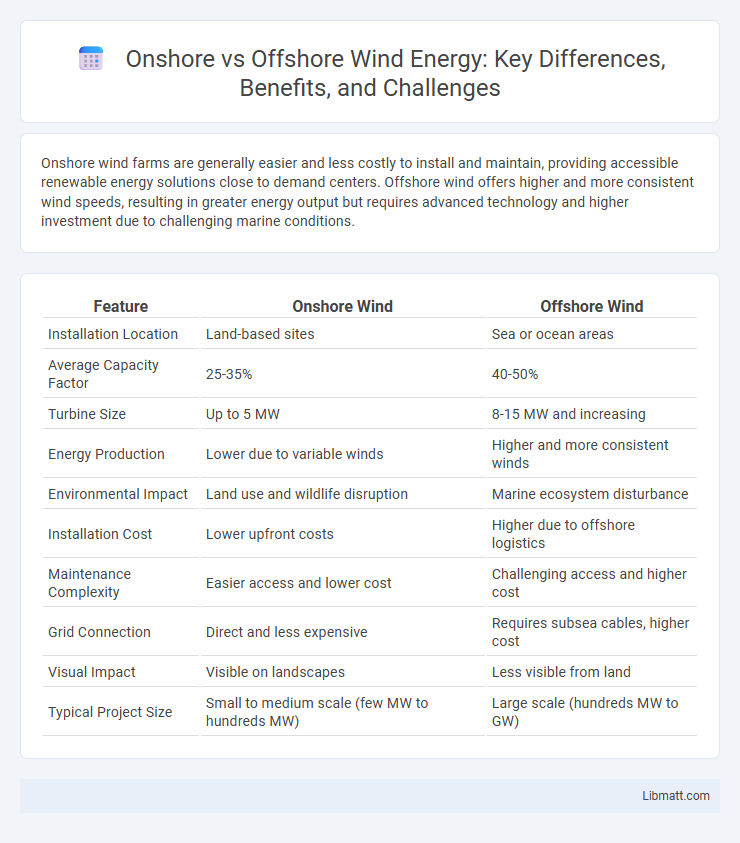Onshore wind farms are generally easier and less costly to install and maintain, providing accessible renewable energy solutions close to demand centers. Offshore wind offers higher and more consistent wind speeds, resulting in greater energy output but requires advanced technology and higher investment due to challenging marine conditions.
Table of Comparison
| Feature | Onshore Wind | Offshore Wind |
|---|---|---|
| Installation Location | Land-based sites | Sea or ocean areas |
| Average Capacity Factor | 25-35% | 40-50% |
| Turbine Size | Up to 5 MW | 8-15 MW and increasing |
| Energy Production | Lower due to variable winds | Higher and more consistent winds |
| Environmental Impact | Land use and wildlife disruption | Marine ecosystem disturbance |
| Installation Cost | Lower upfront costs | Higher due to offshore logistics |
| Maintenance Complexity | Easier access and lower cost | Challenging access and higher cost |
| Grid Connection | Direct and less expensive | Requires subsea cables, higher cost |
| Visual Impact | Visible on landscapes | Less visible from land |
| Typical Project Size | Small to medium scale (few MW to hundreds MW) | Large scale (hundreds MW to GW) |
Introduction to Onshore and Offshore Wind Energy
Onshore wind energy harnesses wind power through turbines installed on land, offering lower installation and maintenance costs compared to offshore setups. Offshore wind energy utilizes turbines placed in bodies of water, typically on continental shelves, benefiting from stronger and more consistent wind speeds that increase energy yields. Both methods contribute significantly to renewable energy portfolios, with offshore wind capacity expected to grow rapidly due to technological advancements and favorable wind conditions.
Key Differences Between Onshore and Offshore Wind
Onshore wind turbines are typically installed on land, offering easier access for maintenance and lower installation costs, while offshore wind farms are located at sea, harnessing stronger and more consistent wind speeds for higher energy output. Offshore wind projects often require specialized equipment and higher initial investments due to challenges like deep water foundations and complex grid connections. Despite higher costs, offshore wind can generate more electricity per turbine, making it a strategic choice for large-scale renewable energy generation.
Wind Resource Availability and Efficiency
Onshore wind farms benefit from easier access and lower installation costs but face limitations due to terrain and lower average wind speeds, typically around 6-7 m/s. Offshore wind farms exploit stronger and more consistent wind resources, with average speeds exceeding 9 m/s, significantly enhancing energy efficiency and capacity factors. Your choice between onshore and offshore wind depends on balancing installation feasibility with maximizing wind resource availability for optimal power generation.
Installation and Infrastructure Requirements
Onshore wind farms demand less complex installation processes and can utilize existing road networks for turbine delivery and maintenance, resulting in lower initial infrastructure costs. Offshore wind installations require specialized vessels, underwater foundations, and robust electrical grid integration due to harsh marine environments, increasing both logistical complexity and capital expenditure. The need for durable materials and long-distance power transmission cables further heightens offshore wind infrastructure requirements compared to onshore projects.
Environmental Impact and Land Use
Onshore wind farms typically have a smaller initial carbon footprint but can lead to habitat disruption, noise, and land degradation affecting wildlife and local ecosystems. Offshore wind farms offer higher energy output with minimal land use, reducing terrestrial habitat loss, but may impact marine ecosystems and seabird migration patterns. Both technologies require careful site selection and environmental assessments to balance renewable energy benefits with ecosystem preservation.
Economic Considerations and Cost Comparison
Onshore wind projects generally exhibit lower installation and maintenance costs, making them more economically viable for regions with accessible land and existing infrastructure. Offshore wind farms, while featuring higher upfront capital expenditures due to complex marine construction and advanced technology requirements, benefit from stronger and more consistent wind speeds, resulting in higher energy yields and improved long-term cost efficiency. Levelized cost of energy (LCOE) comparisons indicate that onshore wind remains the cheapest renewable option per megawatt-hour, but offshore wind costs are decreasing rapidly due to technological advancements and economies of scale.
Maintenance and Operational Challenges
Onshore wind farms benefit from easier access for maintenance crews and quicker response times, reducing downtime and operational costs. Offshore wind turbines face harsher environmental conditions such as saltwater corrosion, stronger winds, and difficult sea access, complicating repairs and increasing maintenance expenses. Advances in remote monitoring and specialized vessels are essential to managing the unique challenges of offshore wind operations.
Energy Output and Reliability
Onshore wind farms typically generate lower energy output compared to offshore wind due to lower wind speeds and more turbulent conditions on land, while offshore turbines benefit from stronger, more consistent winds leading to higher energy production. The reliability of offshore wind is enhanced by fewer obstacles and stable marine environments, resulting in less downtime and maintenance disruptions. Your energy portfolio can gain stability and increased output reliability by investing in offshore wind despite higher initial costs.
Future Trends and Technological Innovations
Onshore wind energy is advancing through the integration of taller turbines and enhanced blade designs to capture stronger, steadier winds, boosting efficiency and capacity. Offshore wind is rapidly evolving with floating platform technologies allowing deployment in deeper waters, unlocking vast untapped wind resources and minimizing visual impact. Emerging innovations such as AI-driven predictive maintenance and energy storage integration are set to optimize grid reliability and reduce operational costs across both sectors.
Conclusion: Choosing Between Onshore and Offshore Wind
Choosing between onshore wind and offshore wind depends on your project's location, budget, and energy goals. Onshore wind farms are typically more cost-effective and easier to maintain, while offshore wind offers higher and more consistent wind speeds, leading to greater energy output. Balancing these factors will help you select the most efficient and sustainable wind energy solution for your needs.
Onshore Wind vs Offshore Wind Infographic

 libmatt.com
libmatt.com